Mastering MODX: Audio Record on DAW, Part I

The MODX features a built-in AUDIO Interface. The Yamaha Steinberg USB driver enables the MODX to act as a 10-in/4-out USB audio interface for your computer system. This allows the MODX to act as your computer’s soundcard, and affords you the opportunity to do high quality digital audio recording to your computer DAW (Digital Audio Workstation) software.
Basic Audio Recording
Let’s connect the MODX to your computer – and learn about how audio is being routed to the computer, including how to ensure that the signal is properly received on an audio track of Cubase. For this basic tutorial, all you need are the following:
- The MODX connected to your computer via a USB cable.
IMPORTANT NOTE: Install the “Yamaha Steinberg USB Driver” version for your particular computer operating system (Mac or PC) and make sure your MODX is updated to the most recent firmware. You can download this directly from the Yamaha website HERE.
- The current version of Cubase AI (provided free to MODX owners via download HERE) or Cubase Pro, installed and updated.
- A pair of quality Studio Monitors connected to the Main L&R analog outputs of the MODX (quality headphones can be used, if you prefer).
We will keep this first tutorial very basic. This way you can see, learn, and understand how the signal is being routed.
In this “signal flow” tutorial we will route audio to Cubase from a MODX PERFORMANCE (simple basic) and we will use it to record a stereo audio track to Cubase.
Prepare the MODX
- Press [UTILITY]
- Touch “Settings” > “Quick Setup”
- Touch the option “Audio Rec on DAW”:
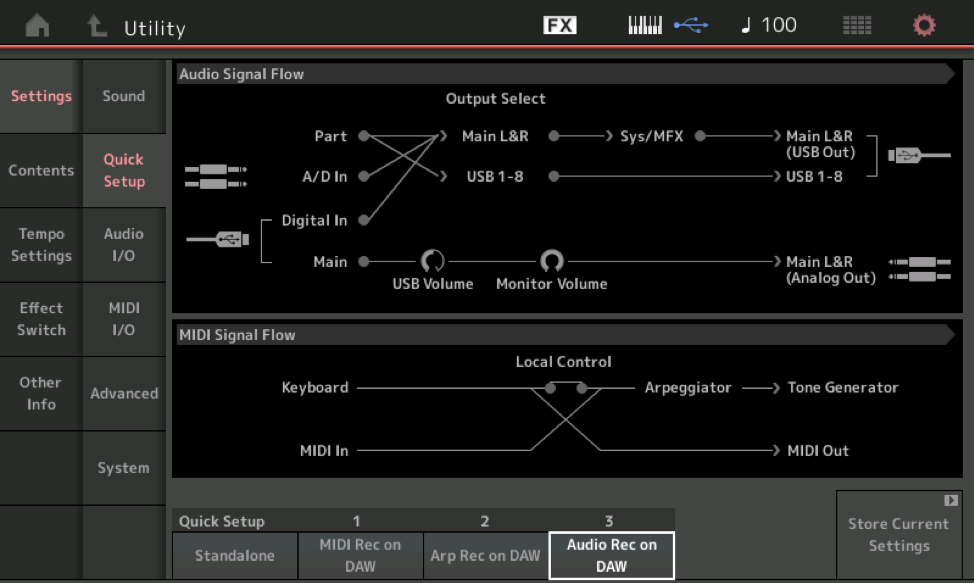
This will set the DIRECT MONITOR SWITCH to OFF. “Direct Monitor”, as we’ll see, determines whether or not, the MODX audio signal travels directly to the analog L&R outputs. When it is ON, you hear yourself playing the MODX through the Main L&R (Analog Outputs) – Basically, the sound of the MODX will travel its normal path to your speakers. But when recording on the computer, the default condition is to turn this Direct Monitoring OFF. This means the only path for audio to travel is through the USB Out connection to the computer. Audio must then be ‘returned’ to the MODX, acting as audio interface, in order to reach the Analog Outs.
What you need to take from this is the following: If DIRECT MONITOR is active – and you are monitoring through the computer – that would be where doubling occurs. The Quick Setup #3 template turns DIRECT MONITOR = OFF. Expect to hear the MODX only after you have your Cubase routing complete – that is, the signal is routed to an active Audio Track with the Track’s Monitor Switch set to ON:
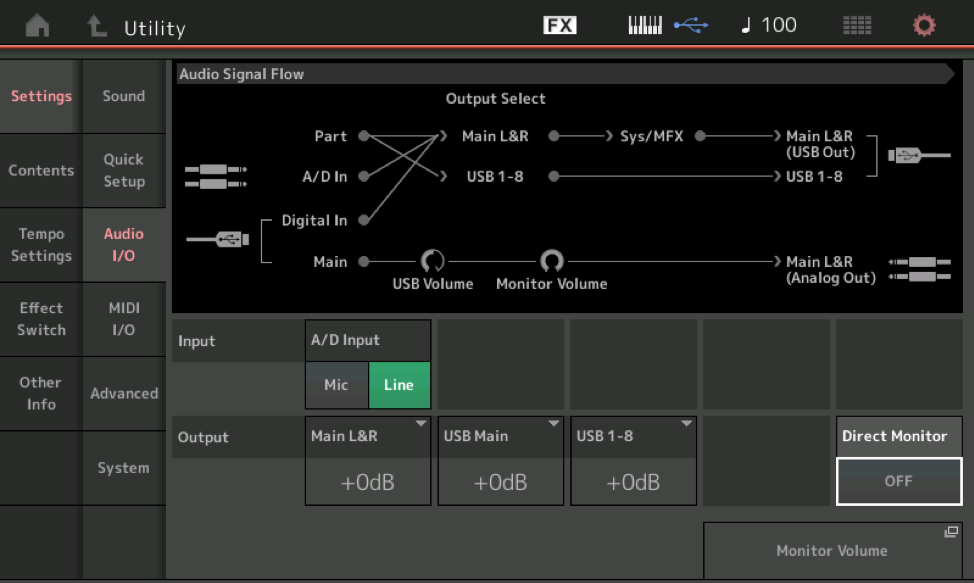
Extra Credit
On the “Audio I/O” screen, move the cursor to highlight “Direct Monitor”. Turn it ON and OFF, and observe the Audio Signal Flow graphic. When ON signal from a PART, whether routed to Main L&R or to a USB 1-8 Output, has a method to get directly to the “Main L&R (Analog Out)”. When OFF signal must traverse the computer in order to reach the Analog Out (your sound system):

In Cubase, the Track has a red Record Ready button, and a tan Monitor speaker button. In order to hear the MODX in a situation where DIRECT MONITOR is OFF, you must be connected to an active audio track with the Monitor Speaker icon selected (shown). The Monitor Speaker icon is there so that you do not have actually place the transport into record in order to hear it. This is helpful, during level setting and run-throughs before recording begins. When the Track is actually placed in RECORD, the Monitor Speaker will be automatically activated.
Using the “Audio Rec on DAW” Template
This Template is specifically designed to route Parts of the current Performance to specific audio Output buses. It is really just a starting point. Be prepared to make changes to this as you go. What we’ll learn here will prepare you to make these assignments as your project requires. It will allow us to send audio on any of MODX’s audio buses (Main L/R or any of the 8 assignable) to the computer.
Note: As with any Template it is ‘general’, you must know if it fits what you want to accomplish. For now, let’s just deal with the factory defaults – later you can customize the QUICK SETUPs to reflect your own workflow.
An audio “bus” simply is a means to transport signal from one place to another along a specific route. One or more passengers (signals) can be assigned to ride any bus we choose, on the way to the designated destination. In the Audio Signal Flow chart above, you can see that “PART”, the “A/D In” and the “Digital In” (USB) are being routed (using the Output Select parameter) set to “Main L&R” and are being ‘bused’ to the “Main L&R (USB Out)” (to your DAW – Cubase). The PART (any of them) can also be routed to any of the 8 assignable USB outputs. This allows discreet recording on your DAW. When you want to take a separate output on a single sound, or drum, you can route it to a single USB bus isolating it for special processing.
The default OUTPUT SELECT assignments made in this factory Template are as follows:
- PART 1 – Main L&R
- PART 2 – USB 1&2
- PART 3 – USB 3&4
- PART 4 – USB 5&6
- PART 5 – USB 7&8
- PART 6 – USB Main L&R
- PART 7 – USB Main L&R
- PART 8 – USB Main L&R
- PART 9 – USB Main L&R
- PART 10 – USB Main L&R
- PART 11 – USB Main L&R
- PART 12 – USB Main L&R
- PART 13 – USB Main L&R
- PART 14 – USB Main L&R
- PART 15 – USB Main L&R
- PART 16 – USB Main L&R
When you touch the QUICK SETUP #3: “Audio Rec on DAW”, the MODX makes specific changes to your System’s setup and to the current Performance. Each of the three QUICK SETUPs are customizable. They can be changed and renamed to reflect your own workflow. For now, just realize that when you tap the template, the stored settings are *sent* and they can reconfigure both MIDI I/O and AUDIO I/O settings. In the case of this AUDIO Template, it also changes the PART OUTPUT configuration within the current Performance (only).
Change the Templates for your needs
A Template sets up a specific routing scenario. It is important to understand exactly what it is doing, because you will need to make the final routing decisions and you are expected to customize the default routing to suit your immediate requirements. We will use this template to do the first example – a simple stereo record using a single Part Performance. We will use the sound in PART 1, which defaults to the “Main L&R” Output. We’ll learn why this particular template will not work for all audio recording needs (again, you are expected to customize the settings as you require). Then we’ll learn to solve routing issue by ensuring that the selected Output is properly routed and there is a corresponding Input in the computer DAW to receive it. This is a per Part decision.
For this basic experiment we want the MODX to run on its own clock (later we will deal with synchronizing the MODX’s MIDI clock to the MIDI clock of Cubase):
- Call up a PERFORMANCE: CFX Stage or Full Concert Grand
These are single PART acoustic piano PERFORMANCEs (green). In the MODX you are working with a multi-channel digital mixer, our piano occupies just one channel of our mixer.
- From the HOME screen, touch “Mixing”:
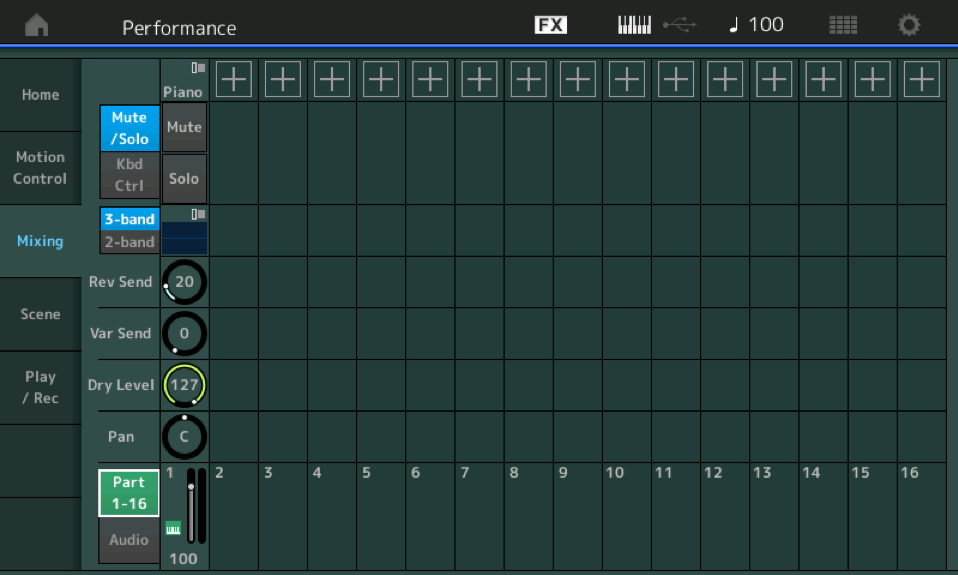
- We have the “Part 1-16” (green) view selected.
We will start here because it is a single PART and we will send audio output to the “MAIN L&R (USB Out)” for recording. As we go along we will learn to setup (bus) multiple audio outputs, as necessary, to record. The lesson here is to create an audio INPUT in Cubase to match each audio OUTPUT you use in the MODX; and then finally create an audio Track to document that signal. Let’s take it one at a time:
- Press [EDIT].
- Select [PART SELECT 1] to view PART 1 parameters. “Part 1 – Common” appear in blue in the lower left corner of the screen.
- Touch “Part Settings” > “General”. “PART OUTPUT” is set here: Touch the box to see the pop-n menu with various options. We want “Main L&R” but you can use the Data Dial to scroll through the possible routing scenarios.
This is where the PART is assigned to an OUTPUT BUS. We are taking the passenger (acoustic piano) and are directing them to the bus labeled “Main L&R” on its way Out via “Main L&R USB Out”:
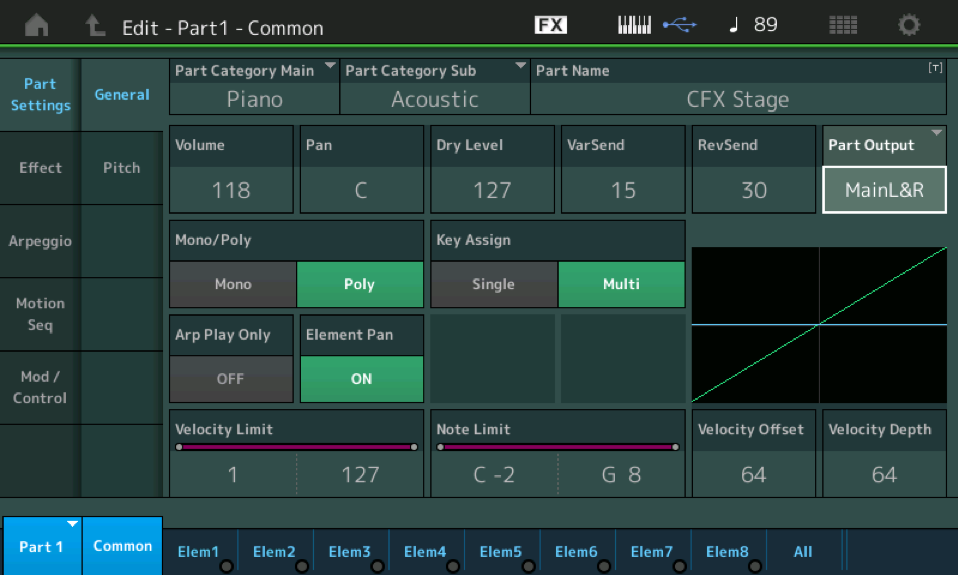
Cubase Project
We will use Cubase in our example, but you can pretty much substitute any professional DAW software that can utilize ASIO protocol (the Yamaha Steinberg USB driver is an ASIO driver) the setup will similar (although the steps to get there may vary:
- Launch Cubase.
- Select the EMPTY Project Template (found under the “MORE” options). This will create an empty Project for this experiment. Click CREATE EMPTY.
- Verify Port Setup.
- STUDIO > STUDIO SETUP > VST Audio System:
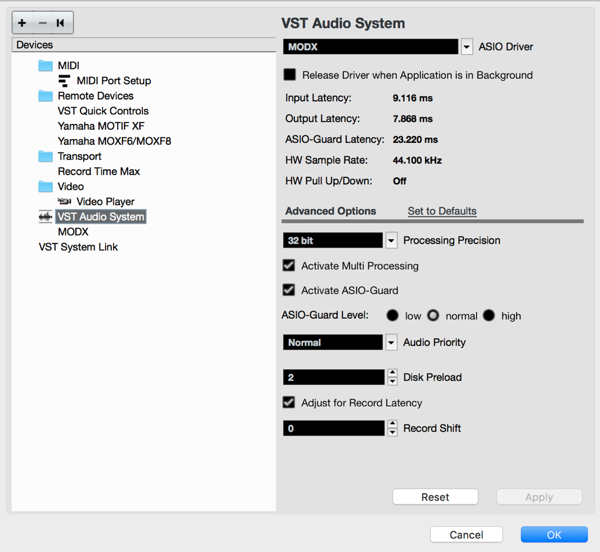
- In the “VST AUDIO SYSTEM” folder, the DRIVER is selected for streaming AUDIO IN and OUT of the computer. This is the ASIO Driver:
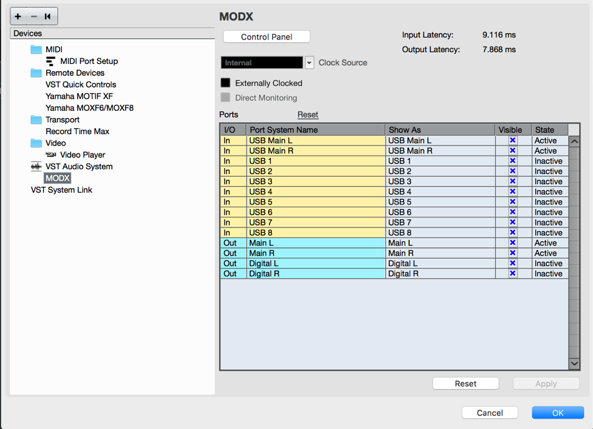
You can see MODX has 10 In Ports (yellow) and 4 Out Ports (blue). Notice that the eight USB buses are listed as IN (from the computer’s perspective, they are INPUTS). Notice also that there are “Main L&R” plus USB 1-8, they are not listed USB 1 through 10. The significance of the “Main L&R” is that it has the SYSTEM and MASTER EFFECT/EQ. (If you are using a DAW other than Cubase and the numbers for the buses are simply 1-10, remember that the first two are the “MAIN L&R”).
If you are using a Windows computer the option for ASIO DRIVER may be listed as “Yamaha Steinberg USB ASIO”.
If you are using a Macintosh computer the option for ASIO Driver will be listed by the product name “MODX”. This is the equivalent setting. The MODX is acting as the Audio Interface for the application.
The “Inactive”, “Active” status (State) column – this will always indicate what resources you are currently accessing. It is not a setting you make (on this screen) as much as it is a status report for each of the ports and whether it is currently being used to bus signal. (You can check if any passengers have been assigned to travel on that particular bus – so it’s a status report, not an assignable function. You do not click on it to turn it on, you make an assignment and it gets reported here). The process is route a PART to a MODX Output, set the DAW software to receive that signal to an Input.
For example, currently it is showing that only the MAIN L/R IN and the MAIN L/R OUT are “active”. The others are activated only when you add an INPUT (Add Bus) in Cubase and connect the MODX Part to that bus. Nothing is assigned to the individual USB buses, 1-8, that’s why they show “Inactive”. If you were to assign a PART to a USB Output 1-8, that item would then show “Active”.
Making the Connections
Next, let’s create a specific connection between the computer and Cubase so that audio we are sending on the “Main L&R” stereo bus from the MODX can be received in the software on an Audio Track. This is done as follows:
- Go to STUDIO > AUDIO CONNECTIONS > INPUTS:

Selecting the INPUTS tab makes sense, because we are connecting the MODX’s “Main L&R” stereo USB bus OUTPUT to Cubase’s INPUTS. Signal flow is from the synth to Cubase.
Typically, there is already a “STEREO IN” created and assigned (we see this in the VST AUDIO SYSTEM > Ports view it is listed as “Active”). This is fine – we can use it.
Likewise, on the OUTPUTS tab the “STEREO OUT” is already created and assigned (also listed as Active). Before we return to the main Track view, click on the OUTPUTS tab. This is where Cubase is set to route audio OUT to its audio interface (which is the MODX). Notice the Cubase ‘Click’ is sent from the computer to the MODX as audio. You do not have to worry about the Cubase Click being recorded because it is only sent to the Computer Output:

Summary: The Cubase Bus “Stereo In” is set to receive audio from the MODX (the Audio Device) on “USB Main L” and “USB Main R” (the Audio Device’s Device Ports). The Cubase Bus “Stereo Out” is set to return audio to the MODX and go to the Main L and Main R.
Rename the Input Bus
The “Stereo In” is audio coming from the MODX arriving at Cubase. You can double click on the name “Stereo In” and rename it “MODX Main” (shown below):
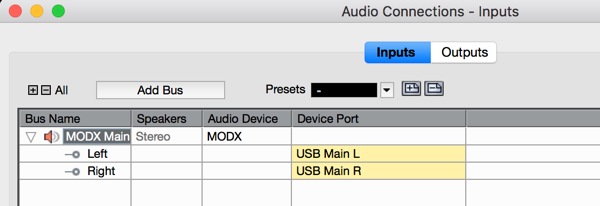
We can now set up an Audio Track, with this Input, and complete our journey to an Audio Track.
Return to the main Cubase Track View screen.
Next, we will need to create an AUDIO TRACK… You can do so by right clicking in the darker grey area on the Track View screen or by going to PROJECT > ADD TRACK > AUDIO.
Add a single Stereo Track:
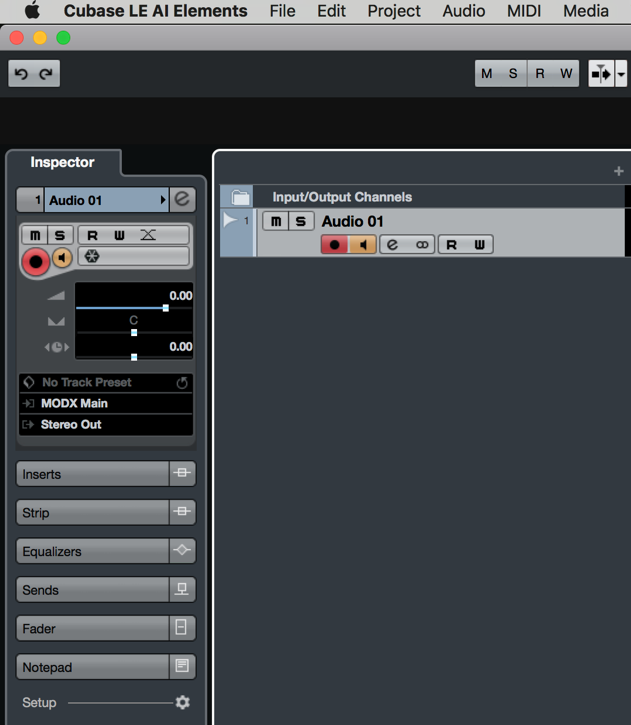
You can see your renamed INPUT: “MODX Main”. The OUTPUT is routed to Stereo Out which is MODX “Main L” and “Main R” as audio interface.
This ensures the signal path to and from the computer. When this track is selected you will hear the MODX.
When the Record Ready and Monitor Speaker icons are activated, it will ensure we can hear what we are doing (remember: “Direct Monitor” is Off by default in this template, meaning we must route audio through the DAW (Cubase) in order for the audio to reach the outputs to your speakers).
This is all that is required to begin recording. The basic recording does not have to involve a metronome or any clock reference – you can simply set Cubase in record and play, if you wish. (Using the Click can, of course, help if you are thinking about adding other parts later… but in this basic recording you can just record as if the DAW was an old-style tape recorder – which didn’t count measures or keep track of beats!)
You can even set Cubase to read out in “SECONDS” (that is, regular minutes/seconds of clock time) for the length of your recording. You do so by either right clicking in the Timeline area that runs the length of the Track Record area, just above the first track; then select “Seconds” or you can go to PROJECT > PROJECT SETUP… > Set the DISPLAY FORMAT = “SECONDS”. (Until we establish MIDI communication, the computer best count in minutes and seconds).
Select the Audio track, then as you begin to play, you should hear your playing and see the audio meter for Track 01 respond. The RED Record Ready icon routes audio to the track, while the TAN Monitor Speaker icon sends audio back to the MODX (as audio interface) via USB:
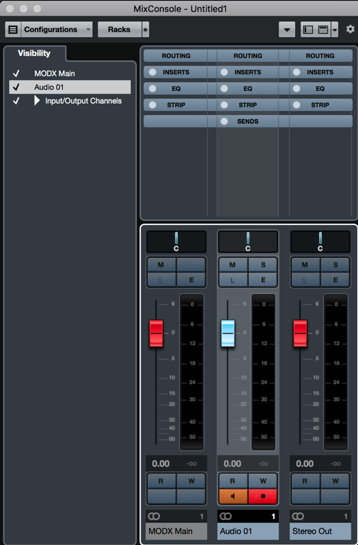
You can open the Cubase Mixer and check your record levels – Go to STUDIO > MIXER or touch F3 on your QWERTY keyboard (Fn+F3 on a Mac).
You will see the “MODX Main” (Audio Input), the Cubase “Audio 01” Track, and the “Stereo Out”. In this situation they all read the same because we are seeing the MODX signal arriving in Cubase, Cubase delivering it to an Audio Track, and the Audio Track outputting data back to the Audio Interface.
RECORD and PLAYBACK to get a feel for operating the Transport and feel of recording.
In our next setup we will introduce you to multiple audio bus recording.
Details and Take-aways
If the Monitor Speaker icon is activated, audio that is returned from Cubase will arrive back in the MODX and pass through the MODX “Monitor Volume” parameter setting.
The Cubase Faders will be set at nominal 0.00. This is typical when recording, the fader is set “open” 0.00 – input gain is regulated at the source (in this case, the MODX). Do not touch the Faders in Cubase, adjust the record level for this channel by increasing or decreasing the OUTPUT level of the source (MODX).
The Cubase Mixer will show you the maximum “peak” level reached – avoid clips.
Level adjustment is not made with the main VOLUME Slider on the MODX – in fact, you can pull the main VOLUME Slider all the way down and audio signal is still arriving in Cubase.
In the Signal Flow diagram below, all signal travels left to right; we have colored in the signal flow so you can follow it to and back from the computer: YELLOW is the signal traveling from MODX on its way to the computer (Cubase sees this as INPUT)… BLUE is the signal returning from the computer and going to the speakers:

- You play a “PART” (yellow line) which is assigned to the “MAIN L&R” Output, which means it travels through the “SYSTEM” and “MASTER EFFECTS” before being routed to the “MAIN L&R (USB Out)”… the USB cable (yellow) is going TO the computer DAW (Cubase).
- At the bottom left, audio ‘returning’ from the DAW (Cubase) via USB (blue) is returned to the MODX’s “MAIN” travels through the MODX’s “USB Volume” and “Monitor Volume” and goes to your speakers via the “MAIN L&R (Analog Out)”.
Conclusion: The audio that is routed via USB OUT to the computer does not go through the main front panel VOLUME slider before it arrives in the computer. So “how loud” your speakers are really has nothing (whatever) to do with what gets routed to the Cubase audio recorder. It will have no effect on the record level. We are making this rather basic and obvious point for a good reason – it is fundamental to understanding signal routing.
So how do you adjust the overall output level of the MODX in this case?
There are actually several places you can affect the overall recorded OUTPUT of the MODX. You adjust the main OUTPUT VOLUME within the PERFORMANCE:
- Press [EDIT]
- Select COMMON
- Touch “General”:
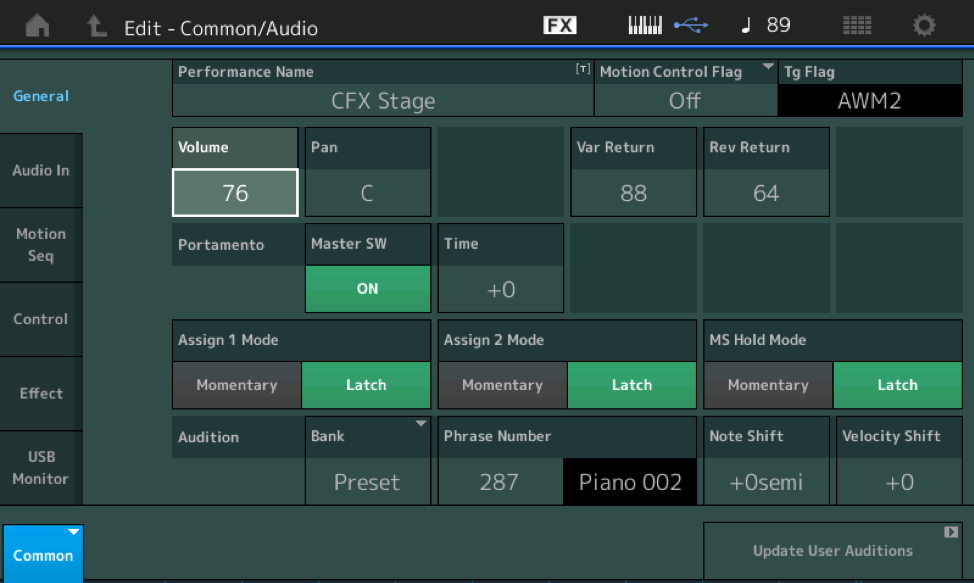
Here you can see the OUTPUT VOLUME of this PERFORMANCE was stored at 76 (on a scale of 0-127). This is where you set the overall output volume of this PERFORMANCE for recording purposes. Try it. Lower this VOLUME and see how it affects the levels arriving in Cubase. Raise this OUTPUT VOLUME as necessary to set your record level.
Always use METERS to judge record Gain. Always use your EARS to judge the quality of the signal, but not to set the Gain – Gain must be set with a METER.
You may have noticed that there is both a PERFORMANCE (overall) Volume for the CFX Stage (76), and there is a PART Volume (individual PART, 118). This is true for each of the sixteen PARTS when you deal with a Multi-Part Performance. The PERFORMANCE Volume obviously represents all PARTs together, and a mix of the individual PARTs makes up the total overall Volume. Trust your Meters to set your level. “How Loud” something is in the room/in your speaker is irrelevant to the amount of signal that is being recorded. Piano is a percussive instrument – leave plenty of headroom (room between the maximum output level and maximum record level) – “noise floor” is not an issue in MODX.
Multiple Output Setup
Many of the PERFORMANCES in the MODX can take advantage of multiple audio outputs. As you go along you can start to take advantage of this powerful feature. You have enough audio buses to accomplish stereo outputs from each MODX PART when recording to a DAW because you can do so in multiple passes.
Assigning PARTS to OUTPUTS and then setting your DAW to receive them as INPUTS is what we’ve just covered. Adding to this basic setup for multiple Output recording is just a matter of repeating the process for each MODX OUTPUT: create a Cubase INPUT and assign that INPUT to an AUDIO TRACK. It is a bus route… you can place one or more passengers (Part signals) on a particular bus, that bus is being routed from point A to point B to point C. Let’s create the first Assignable Output Bus:
- In Cubase, go to STUDIO > AUDIO CONNECTIONS > INPUTS tab > Click “Add Bus”.
- Add a Stereo Bus.
- “STEREO IN” set to receive audio from MODX on “USB 1” and “USB 2” (See graphic below):
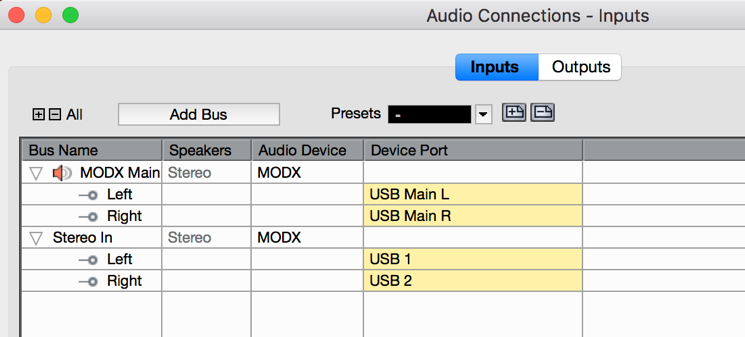
In this fashion you can ADD new Buses for additional routing. Each Bus that you add creates a discreet path (bus route) between the MODX and Cubase. Remember we can have a total of 4 stereo pairs in addition to the Main L&R (later we’ll learn that you can setup mono pathways as well). This will come in handy when recording MULTI PART Performances where we may want to isolate each PART on a separate AUDIO TRACK!
In this case, add STEREO BUSES, as you require. (Screenshot is from a Macintosh).
Any time an AUDIO TRACK is set to receive signal from “MODX Main” it will be receiving audio from the MODX’s “Main L&R”.
Any time an AUDIO TRACK is set to receive signal from “STEREO IN” it will be receiving audio from the MODX’s USB 1/2. And so on, for each Audio Device/Device Port pairing you create. All PARTS that you assign to this pair will be routed on the same bus to the same destination.
Extra Credit
By default, the “USB Main L”/”USB Main R” contain both the SYSTEM EFFECTS and the MASTER EFFECTS/EQ, the eight assignable (USB 1-8) outputs go to those outputs without passing through the System (Reverb and Chorus) and the Master Effects or Master EQ. Each of the 8 USB buses allow the sounds to use their dual Insertion Effects. The difference between the “Main L&R USB Out” as a stereo pair and any of the numbered USB stereo pair Outs is the SYS/MFX/MEQ blocks. If you Bypass the System, Master Effect and Master EQ, they are the same as any of the numbered USB stereo pairs. This can be useful in some setup scenarios.
This mimics a real-world situation where a musician can have their own personal effects (those being the dual Insertion Effects), while the studio mixer has two auxiliary Sends (Rev Send and Var Send) to shared Effects (typically Reverbs and Time Delays). Often on recording projects things like reverb are not initially recorded but instead added at the final mixdown. The routing system here supports working this same way, if you wish. If you would rather add the System Effects and Master Effects (shared effects) later, at final mixdown, you can BYPASS those specific blocks as follows:
- In the top center of the screen you see the letter FX, if you touch that area you will be taken to the “Effect Switch” screen. Alternatively, you press [UTILITY] > touch “Effect Switch”. Here you can select to Bypass the Effect Blocks you do not want to use, globally:
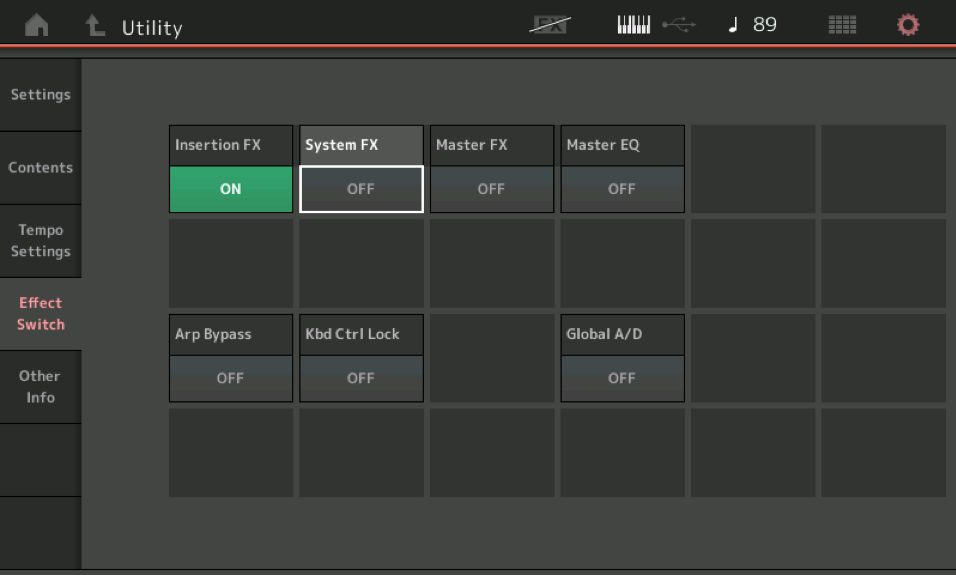
When any of the Effect Blocks are ‘bypassed” you will see a line through the “FX” icon on the top line (shown above).
By turning OFF the System FX, the Master FX and the Master EQ Blocks, items assigned to the “Main L&R” will arrive at the Audio Track without those shared effects. By leaving the Insertion FX Block active you can continue to use the Effects programmed into the instrument PART. Again, this is a production decision and one that you will make on a per Project basis. The advantage of waiting until final mixdown to add effects like Reverb has a long history as a studio practice. It is predicated on the fact that it is very difficult to change your mind about “how much” reverb is right until you have all instruments assembled. You usually want to have all the instruments playing together, because the differing SEND amounts to the Reverb chamber add to the illusion of ‘placement’ in the stereo panorama – placing instruments before they are all present can be counterintuitive.
When you listen to music in stereo, the illusion of something being slightly to your right or left or in the dead center helps you picture a music ensemble playing in a room. The ear/brain use the reflections (reverberations) to help locate and position where a sound is coming from… the amount of Send from instrument can influence an illusion of distance from the listener.
To Be Continued in “Mastering MODX: Audio Record on DAW, Part 2″…
In the meantime, share your questions/comments on the Forum here!
Keep Reading
© 2025 Yamaha Corporation of America and Yamaha Corporation. All rights reserved. Terms of Use | Privacy Policy | Contact Us